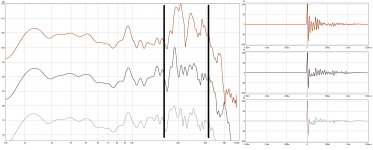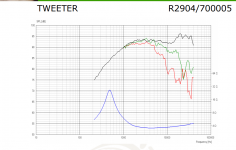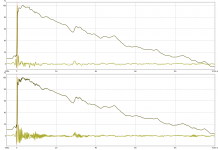I'd recommend a summary, yes. The design you have is very clean and broad-band. I think it would facilitate others to pull it into one concise place. This thread is extremely long.
I assume that the SPLs shown in the FR plot are calibrated?
Chris
I assume that the SPLs shown in the FR plot are calibrated?
Chris
Ah, yes I can see how that first post could be a little misleading as the drawings were X's initial concepts - but a fair bit removed from my plans!
It is a long thread - I should really put a summary post in somewhere.
Bushmeister,
If you want I can insert a link to the summary post in post 1. I probanly need to clean up post 1 anyone as I was trying capture some of the progress as it was happening. Now that it is done, maybe remove a lot of the in progress highlights and leave it to the reader to go through the thread.
I don't think a new thread would be good - it would be better to keep it all here as the development process is all here.
I can even insert your summary into the first post if you write it as a post on this thread.
Last edited:
OK - you're right X - that seems much better.
I will start pulling together a summary then post it here - probably tomorrow - then if you could link to it, or paste it into the first post - that would be great!
I will start pulling together a summary then post it here - probably tomorrow - then if you could link to it, or paste it into the first post - that would be great!
A summary design would be fantastic- these threads are often really hard to go from "Wow that's cool" to "Okay, I need to buy XYZ and do ABC".
You are quite right wesayso,
In fact that is part of the reason I wanted to 'let the dust settle' and spend some hours just listening.
OK. So as you know, I have a few nice speakers for direct comparison -
One uses the scanspeak 12MU for the mid (the most important driver in a 3-way in my opinion), and one the Volt VM752 - both speakers are optimized as far as I can take them with sorbothane, extensive bracing, damping etc. etc.
So what amazes me is the sound from these synergies. There is only a few hundred quid of drivers in these things and the sound is incredible.
Don't get me wrong - the three way sealed monitors I designed are excellent 'social, party speakers'. i.e. - they create a very wide sound stage which doesn't collapse off axis - they create a true 'wall of sound'.
But the sound stage is an enveloping kind of 'they are here' which probably is not completely true to the recording, I think largely a result of their very broad, even power response in room:
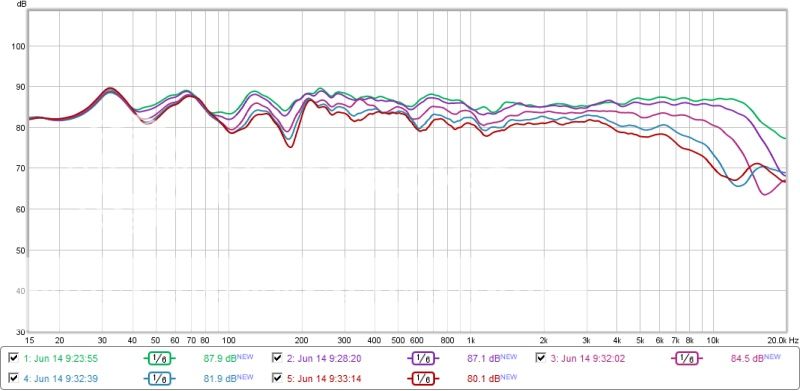
The larger three-way prestige based speakers (but my own crossovers and cabinet mods), have a less pronounced broad directivity, due to the VM752 being horn loaded and the known beaming of the Scanspeak R2904/7000.09 ring radiator.
These are obviously high resolution units too and a lot of time went into optimizing the cabinets with additional bracing and damping to remove cabinet coloration (a problem with the stock kit enclosure).
However, I still feel our home cooked Xbush synergy sounded better.....
They are all fabulous speakers, they all sound different as a result of design considerations and I guess a lot of it is down to personal taste....
BUT, without doubt the Xbush synergies have better resolution, sharper imaging, and create a soundscape which moves from 'they are here' to 'I am there' more than the others.
The window into the recording is much more transparent - I can hear the acoustic space in the background of the recording very clearly.
I am almost certain this is due to the absence of diffractions/reflections from the CD the synergy design provides:
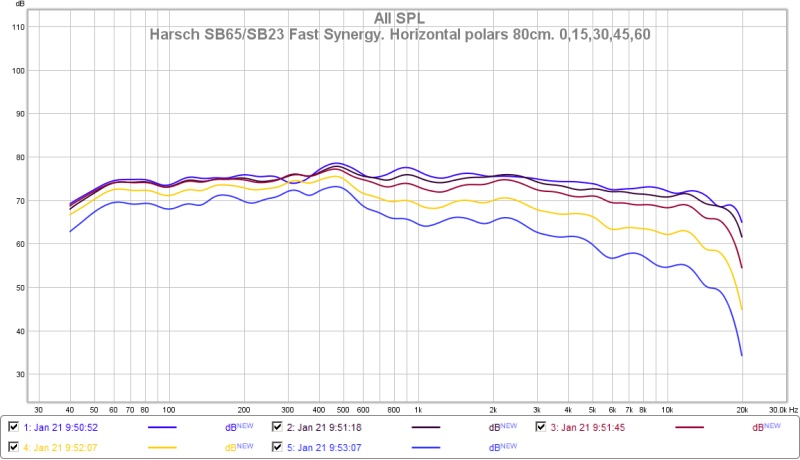
However, again it s a choice of design considerations. The sweet spot, particularly for my sealed monitors is almost the whole room, whilst for the Xbush is perhaps a two seater sofa - (although I suspect this is partly due to a restricted maximum listening distance in my room).
So in summary, for selfish single or perhaps two person critical listening, when you want the highest fidelity into the recording, the Xbush reigns supreme.
However, I would not choose them for my living room party speakers, and I would not be allowed to put them there anyway as currently they have virtually zero WAF! (Also an important design consideration in some households...)
So I am awaiting the conversion of my garage into a dedicated listening room. They will likely be repainted, and placed upon a 100L braced cab of similar width/depth housing an 18inch woofer to cover from ~100hz down.
I can then selfishly enjoy some of the most incredible listening experiences I have had, on my own with a nice single malt, without anyone commenting on how 'large they look'. 😀
Wow thanks sharing experience so detailed and also planning a summary, looks like speaker is well over average high performer, congratulation. Has been a pleasure to follow project and your skills, especially when subject is damping cabinets and share that knowhow. Even myself have too many plans will look forward a summary because above description of sound performance is very hard to resist 😀.
Regarding:
The window into the recording is much more transparent - I can hear the acoustic space in the background of the recording very clearly.
Datasheet for SB65WBAC25-4 show a 10dB raise where plot ends at 20kHz and below is my 3x driver from the distortion test measured at 96kHz. They seems pretty hot up there from 15-32kHz and not very smooth, and maybe they have even higher reach in that my measurements setup had not mic preamp Behringer Xenyx 802 and old power amp in a Luxman R-2050 reciever's frq response calibration included. Can't say if its related but something to think about in learning process of what we hear, not that >30Khz reach is unusual for tweeters, but real tweeters have usual more smooth response and clean IR. Plots are 1,5mS window without any smoothing.
Attachments
Last edited:
Thanks for the write-up bushmeister. So I take it that if you have the space, a bigger horn with a lower cut-off might be worthwhile to try. Good to know up front.
This one still works pretty good though and even though you'd need big bookshelves might be a great way to experience this concept and end up with a great set of speakers.
As you are planning your garage and add some room treatment you might end up spending more time there than planned! 🙂
This one still works pretty good though and even though you'd need big bookshelves might be a great way to experience this concept and end up with a great set of speakers.
As you are planning your garage and add some room treatment you might end up spending more time there than planned! 🙂
Isn't the bushmeister's horn speced at 60°*40° ?
This is probably one of the main reason you have the 'i am in there' feeling as you reduce room influence of great amount.
This is probably one of the main reason you have the 'i am in there' feeling as you reduce room influence of great amount.
Thanks for the write-up bushmeister. So I take it that if you have the space, a bigger horn with a lower cut-off might be worthwhile to try. Good to know up front.
This one still works pretty good though and even though you'd need big bookshelves might be a great way to experience this concept and end up with a great set of speakers.
As you are planning your garage and add some room treatment you might end up spending more time there than planned! 🙂
Well whilst a bigger horn may be better - and Chris clearly feels so, I am not 100% convinced on this.
Given that this horn controls wavelengths well over 2 feet in size (500hz), I am not sure about the diffraction/reflection issues at these wavelengths. I suspect that bass traps, room treatment of first reflection points etc may be just as benficial.
Having read up on CD a fair bit prior to choosing the xt1464 horn, I think that controlled directivity is really important from 500 up, so this horn size does achieve that well.
As Kirivium points out - it not only achieves that well from 500 hz up, but also does this over a narrower window. What is easy to forget sometimes, is using wide horizontal beam width (i.e. over 90 degrees) may give a large sweet spot, but it also illuminates the chair in the corner, the edge of the cabinet on the side wall etc. The 60 degree horizontal beam I settled on was chosen to avoid any unwanted reflections - smaller sweet spot - but I only 'light up' the listening sofa......
If you are using two >90 degree horns - unless your room is very large - you are going to get unwanted reflections.
So all in all - I am extremely happy with the choices I have made, and currently wouldn't change them.
Last edited:
Datasheet for SB65WBAC25-4 show a 10dB raise where plot ends at 20kHz and below is my 3x driver from the distortion test measured at 96kHz. They seems pretty hot up there from 15-32kHz and not very smooth, and maybe they have even higher reach in that my measurements setup had not mic preamp Behringer Xenyx 802 and old power amp in a Luxman R-2050 reciever's frq response calibration included. Can't say if its related but something to think about in learning process of what we hear, not that >30Khz reach is unusual for tweeters, but real tweeters have usual more smooth response and clean IR. Plots are 1,5mS window without any smoothing.
Very interesting idea Brytt!
I am certain I have no hearing past 19,000hz. And I have EQ'ed the SB65 fairly flat - right up so am not certain it would be the 'hot top end'.
I think as discussed above the main reason you can hear into the recording so well is the great reduction in room interaction. Narrow beam width, controlled down to 500hz - very little to mask the background acoustic clues.
The Scanspeak R7000 I use also has a slightly hot top end - but isn't the same experience.
Attachments
It has to be the reduced room interactions combined with low distortion that makes the sound special. The experience of hearing my Trynergy for the first time was very memorable. It stuns you because it is so clean and dynamic with lots of headroom.
It has to be the reduced room interactions combined with low distortion that makes the sound special.
It's sure.
I tend to agree about what Bushmeister says of 500hz as 'low limit' for directivity control from horn itself.
Below that can not be detrimental but trade off for horn size become an issue for most.
And anyway room treatment become an issue too: minimum wall size to redirect room reflections far from sweetspot is in the range of 2 meters (for 500hz and up) which become problematic if the room is not dedicated once you take angling of side wall into account.
Absorption and diffusers could be beneficial in the range below 500hz (but diffusers will be 'big' and need space from sweetspot (rearwall)).
Very interesting idea Brytt!
I am certain I have no hearing past 19,000hz. And I have EQ'ed the SB65 fairly flat - right up so am not certain it would be the 'hot top end'.
I think as discussed above the main reason you can hear into the recording so well is the great reduction in room interaction. Narrow beam width, controlled down to 500hz - very little to mask the background acoustic clues.
The Scanspeak R7000 I use also has a slightly hot top end - but isn't the same experience.
Probably reason is mostly pay back from the clever build plan and steered CD, enjoy sound and whiskey : )
Mention it because had the measurements taken at higher bandwidth and my hearing is gone past 16kHz but if i run DSP at 96 or 192kHz and put high shelve boosts above 20kHz i hear a very clear change and if on axis it actual feels like one can hear deeper into recording and room. Below is 10F in FAST setup with simple high shelve boost verse normal 18kHz roll off, and because its not smooth above its normal roll off slope it starts look like SB65 with added HF ringing up to around 1,5mS point.
Attachments
A summary design would be fantastic- these threads are often really hard to go from "Wow that's cool" to "Okay, I need to buy XYZ and do ABC".[/QUOTE
Exactly. Nicely put.
Why not show the IR and STEP, as measured at the listening position, along with the filtered IR and a spectrogram (to about 30 ms), or even better an APL_TDA plot.
If you do this, show the first ~25 ms in the IR, STEP can be in the same plot at that scale. The filtered IR could show 300 ms, and about 60 dB down from the top peak. The spectrogram about 30 ms (to show the early wave front) and for starters down to 25 dB?(*) That would show a lot of room for most type of speakers. Lately I love to look at how APL_TDA plots show it, you can still "see" the room. But a combination of both shows even more.
All three of them would/should show if there's less room interaction. Not trying to be a bore here. But as long as we are playing, let's see the graphs that support the speculation. That's the reason why I have posted that many graphs on my own thread. Let's learn how these things look and what the differences are. Not at 0.5 meter but at the listening position. In the end, that's where the magic should happen 🙂.
I'm hoping you're willing to play along 😉. Even better if you show it from the conventional speaker as well. Then we can compare even more data. In the end, the measurements should be able to tell us a story. All of the combined views should teach us where to look. Not the semi ideal close up measurements, the ones at the listening position, that's where we listen after all.
Sure, I know a filtered IR isn't telling everything, but we've got to start somewhere. Are you guys willing to play? I'd love to see that data. Even the early waterfall plots like I've asked about earlier on the thread tell me something. Let's learn people! Stop guessing, at least as far as we can. There will be enough left to guess about, I promise 😉. There's still more to be seen of coarse, but there's hardly any data like this around! Let's start somewhere! Sure this will be your room", but let's link a couple of these plots to what the subjective listening impressions say.
(*) = My spectrogram plots have only been to -15 dB and -20 dB for the most part, though I did post a -40 dB plot once. At -20 dB, it showed enough room interaction in my case, while the -15 dB plot was pretty clean. All taken at the listening position. I believe this is a great way to learn a bit more.
If you do this, show the first ~25 ms in the IR, STEP can be in the same plot at that scale. The filtered IR could show 300 ms, and about 60 dB down from the top peak. The spectrogram about 30 ms (to show the early wave front) and for starters down to 25 dB?(*) That would show a lot of room for most type of speakers. Lately I love to look at how APL_TDA plots show it, you can still "see" the room. But a combination of both shows even more.
All three of them would/should show if there's less room interaction. Not trying to be a bore here. But as long as we are playing, let's see the graphs that support the speculation. That's the reason why I have posted that many graphs on my own thread. Let's learn how these things look and what the differences are. Not at 0.5 meter but at the listening position. In the end, that's where the magic should happen 🙂.
I'm hoping you're willing to play along 😉. Even better if you show it from the conventional speaker as well. Then we can compare even more data. In the end, the measurements should be able to tell us a story. All of the combined views should teach us where to look. Not the semi ideal close up measurements, the ones at the listening position, that's where we listen after all.
Sure, I know a filtered IR isn't telling everything, but we've got to start somewhere. Are you guys willing to play? I'd love to see that data. Even the early waterfall plots like I've asked about earlier on the thread tell me something. Let's learn people! Stop guessing, at least as far as we can. There will be enough left to guess about, I promise 😉. There's still more to be seen of coarse, but there's hardly any data like this around! Let's start somewhere! Sure this will be your room", but let's link a couple of these plots to what the subjective listening impressions say.
(*) = My spectrogram plots have only been to -15 dB and -20 dB for the most part, though I did post a -40 dB plot once. At -20 dB, it showed enough room interaction in my case, while the -15 dB plot was pretty clean. All taken at the listening position. I believe this is a great way to learn a bit more.
Last edited:
Ooooo. A challenge! I like that wesayso!
But seriously, at present I am trying to do a write up of the build. And I have moved the X-bush's out of the way whilst I listened to the prestige again - so will have to do some swopping about to sort it.
When I have a chance - possibly this weekend......we can play - I promise!
But seriously, at present I am trying to do a write up of the build. And I have moved the X-bush's out of the way whilst I listened to the prestige again - so will have to do some swopping about to sort it.
When I have a chance - possibly this weekend......we can play - I promise!
That would be cool. Something to learn from that for all of us.
This has been a fun project, and the more data we see, the more we could learn. Usually the plots stop at a couple of FR measurements at the listening position. But to tell us a little of what we hear we need to look at more than that.
By the way, the Demo version of APL_TDA can make the 3D and 2D plots, you just can't save the data. Screen grabs work for this purpose.
Beside filling up my own thread with this type of data, we also have someone with a marvelous treated room... the more we see, the more we can stand a chance of linking what we see to what we hear. It will still be difficult, and the IR usually could tell us more if we "pick it apart". But let's start somewhere. Thanks for playing 🙂.
This has been a fun project, and the more data we see, the more we could learn. Usually the plots stop at a couple of FR measurements at the listening position. But to tell us a little of what we hear we need to look at more than that.
By the way, the Demo version of APL_TDA can make the 3D and 2D plots, you just can't save the data. Screen grabs work for this purpose.
Beside filling up my own thread with this type of data, we also have someone with a marvelous treated room... the more we see, the more we can stand a chance of linking what we see to what we hear. It will still be difficult, and the IR usually could tell us more if we "pick it apart". But let's start somewhere. Thanks for playing 🙂.
Probably reason is mostly pay back from the clever build plan and steered CD, enjoy sound and whiskey : )
Mention it because had the measurements taken at higher bandwidth and my hearing is gone past 16kHz but if i run DSP at 96 or 192kHz and put high shelve boosts above 20kHz i hear a very clear change and if on axis it actual feels like one can hear deeper into recording and room. Below is 10F in FAST setup with simple high shelve boost verse normal 18kHz roll off, and because its not smooth above its normal roll off slope it starts look like SB65 with added HF ringing up to around 1,5mS point.
BYRTT, don't forget the low end of the FR curve... lot's of fun to be had there too! It's a great "atmosphere builder" to have the low end right (or close to it).
Love your recent STEP plots though 😀. Is this at listening distance?
All three of them would/should show if there's less room interaction.
Yes Ronald. And if compared to the other more conventional (high quality) loudspeakers of Bushmeister it's going to be very interesting.
I predict ( 🙂 ) that past 1khz it'll be obvious the horn/room will be much more clean and show less ER.
One thing is going to be difficult however: to find a place where to locate all speakers for fair comparison (vertical axis).
Moves of only a couple of inch can have a definitive influence on results and approximate the listening spot of vertically stacked unit and pointsource is not so easy.
Bushmeister when you listened to your horn did you toed them? If yes how much angle?
- Home
- Loudspeakers
- Multi-Way
- A Bookshelf Multi-Way Point-Source Horn
